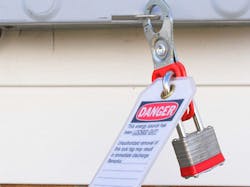While lockout/tagout (LOTO) is an OSHA-mandated safety practice, sometimes practicing it can be very dangerous because of unsafe conditions. These conditions may exist due to design errors, installation errors, maintenance errors, inadequate maintenance, and documentation problems.
Unless you know the facility is run in “tight ship” fashion, assume these issues exist until you verify otherwise. Some examples:
- Design errors: The designer “saved money” by omitting local disconnects on several loads, using the branch or feeder breaker for that purpose. This means opening under load.
- Installation errors. The disconnecting switch is installed such that you can't stand to the right side of it and operate it with your left hand.
- Maintenance errors. Cover bolts are missing.
- Inadequate maintenance. The condition of the equipment is unknown, due to a failure to perform the recommended maintenance at the recommended intervals. You must assume a worst-case scenario.
- Documentation problems. A facility either has controlled drawings or it has outdated drawings. The latter cannot be relied upon.
About the Author

Mark Lamendola
Mark is an expert in maintenance management, having racked up an impressive track record during his time working in the field. He also has extensive knowledge of, and practical expertise with, the National Electrical Code (NEC). Through his consulting business, he provides articles and training materials on electrical topics, specializing in making difficult subjects easy to understand and focusing on the practical aspects of electrical work.
Prior to starting his own business, Mark served as the Technical Editor on EC&M for six years, worked three years in nuclear maintenance, six years as a contract project engineer/project manager, three years as a systems engineer, and three years in plant maintenance management.
Mark earned an AAS degree from Rock Valley College, a BSEET from Columbia Pacific University, and an MBA from Lake Erie College. He’s also completed several related certifications over the years and even was formerly licensed as a Master Electrician. He is a Senior Member of the IEEE and past Chairman of the Kansas City Chapters of both the IEEE and the IEEE Computer Society. Mark also served as the program director for, a board member of, and webmaster of, the Midwest Chapter of the 7x24 Exchange. He has also held memberships with the following organizations: NETA, NFPA, International Association of Webmasters, and Institute of Certified Professional Managers.
